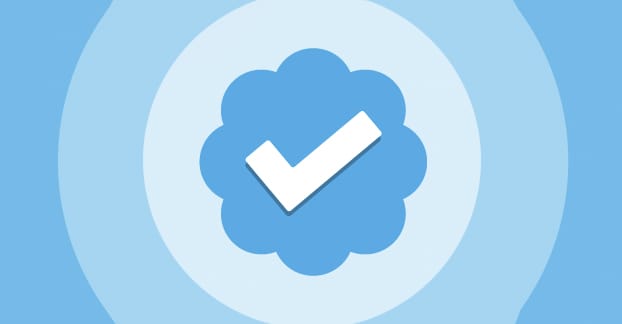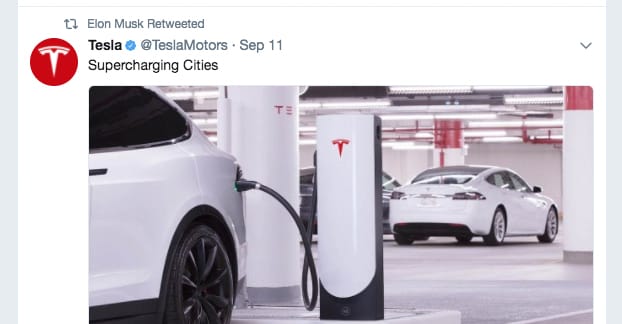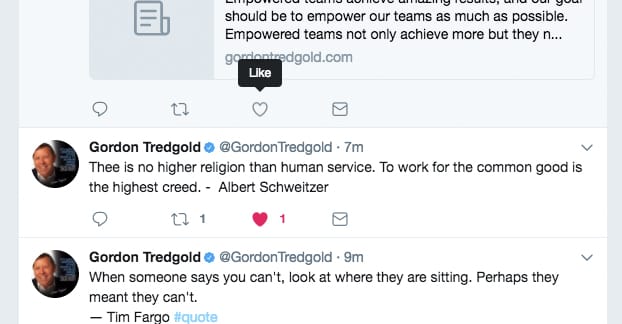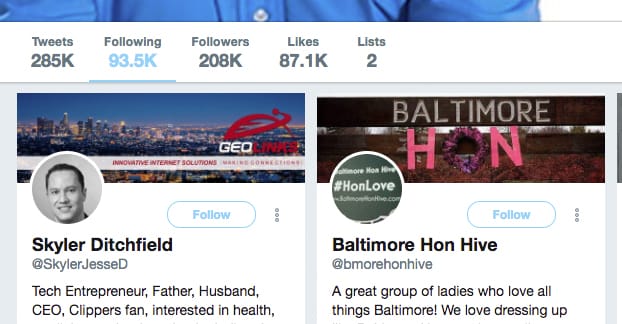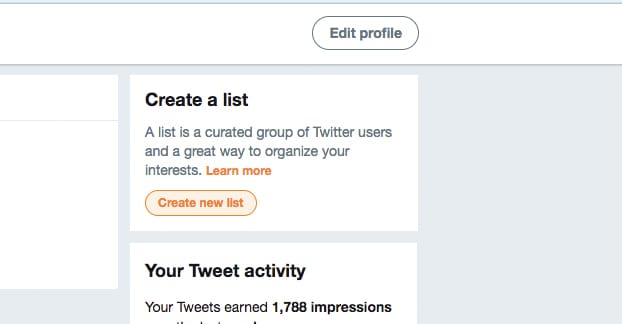One key element to success on Twitter is not just gaining followers, but gaining good followers. Anyone can hop on Twitter and gain a few hundreds followers just by posting content and jokes. There are bot gimmick accounts with more followers than I’ll ever have unless I somehow become successful in a Hollywood career.
When you get high quality followers, you get people who come with their own audience. You become part of an exclusive club, most of the time. For example, Elon Musk only follows 47 accounts, most of which are either science-related, goofy pop culture, or news agencies where he gets his awareness of current events in tech. Neil deGrasse Tyson similarly only follows 42 accounts, most of which are either popular public figures or science-focused accounts.
I can click and see every account Elon Musk follows, and I can bet that they’re going to have some reasonable level of value simply because these high level influencers follow them. If Elon Musk followed me, other people would see that I’m on this list of his top 50 sources of information on Twitter. That alone can bring in new followers and new attention from Elon’s followers.
The primary benefit of being followed by a high profile influencer – generally a verified account, as per the title of this post – is that they have their own large audiences. Sure, if Elon followed me, I’d be given attention from people who pay attention to those kinds of things. However, the real value comes from if he decides to retweet me.
I might tweet and have my post put in front of a few hundred or a few thousand people. If I use the right kind of trending hashtag, I might get another few thousand or ten thousand hits. If Elon retweeted me, my post is put in front of his audience of 12.6 million followers.
Of course, Elon probably isn’t a great example. If you look through his tweets, almost every retweet of his is someone talking about him or is a post from one of his business ventures, like Tesla, SpaceX, or the Boring Company.
A better and potentially more reasonable example would be William Gibson, science fiction author of Neuromancer, Mona Lisa Overdrive, Burning Chrome, and other stories considered the foundation of Cyberpunk. He only follows 225 people, so being followed by his account is still a relatively exclusive club. He only has 225,000 followers, so his potential audience is a lot smaller, but it means he’s a lot more down-to-earth on Twitter.
More importantly, Gibson retweets like 90 different posts per day. He’s a machine that spreads a ton of awareness of a ton of content to his audience. It’d be great if he followed you, because you’d see fairly regular retweets whenever you posted about something that caught his fancy.
Some celebrities are very likely to follow you, but won’t be super valuable when they do. Ellen DeGeneres has 36,000 people she follows, and Yoko Ono follows almost a million accounts. Both of them are pretty likely to follow you if you’re in the right place at the right time, but neither of them is going to see your content in their feed and retweet it. You don’t gain anything from them following you unless someone is specifically looking at who follows you and designs to assign importance to the names rather than the context.
Anyways, that’s enough about why you should get verified accounts to follow you. What you really want to know is how, right? Let’s talk about that.
Be Worth Following
The number one thing you have to do if you want verified users to follow you is be an account that’s worth following. Even if you follow every other step on this list, if all your account does is retweets a handful of low quality blogs, no one is going to want to follow you. Influencers tend to be very picky about their follows, because they know and understand that they’re influential. They don’t want their feeds to be cluttered. Those verified users with hundreds of thousands of accounts on their followed list? They tend to use lists or third party filtered feeds to view Twitter so they don’t see most of the crap in their feed.
How do you become an account worth following? Generally it means you have to be active on a regular basis and in your defined niche. You need to know who you are, who your audience is, and what kind of content they like. You want to be a specialist, not a generalist, so you can target good specific influencers. Fix mistakes you’re making with your account and improve moving forward if you want to have any success at all.
Pick the Right Accounts to Target
You need to find the appropriate accounts to target and get to follow you.
I’ve already mentioned some of the pitfalls above.
- They can’t have too many people they follow, or you’ll be lost in the crowd and won’t gain any value.
- They should commonly retweet or engage with the people they follow; if they don’t, they likely won’t give you much value.
- They should be verified. They don’t have to be, but the purpose of this post is focusing on verified accounts, so you might as well add that to the filter list.
- They should have a decently sized audience. Too small an audience and you won’t get much out of them. See: any of the people on this list.
- They should be active. There’s no point in trying to get the attention of a verified account that hasn’t posted in a year or more.
Verification is easier than ever before, so you’ll want to be a little more aggressive with filtering than you might have been a couple years ago. You don’t need to be a massive celebrity to be verified now, you just have to be noteworthy.
Engage with Influencers in Their Domain
Once you have a target in mind – and you should put together a list – the first thing I like to do is go to their website and poke around. Follow their blog and start engaging with their posts. What you want to do is make sure whatever system they use for comments has an account for you all registered and ready to go. Most importantly, you want it to share a profile picture with your Twitter account.
The goal here is to become a familiar face. Start leaving insightful comments on their blog posts, a few hours or so after they’re published. You don’t want to see too eager, but you also don’t want to wait so long that they no longer monitor the post and miss your comments.
I specify insightful comments here because you want to actually bring value to the table. You want to start a conversation and get people engaged with the post. This benefits the blogger, and they’ll be more likely to pay attention to your content.
That’s all a setup for when you start doing the same thing on Twitter. They’ll recognize you from both places, and associate you with insight and value.
Follow People They Follow
While you’re doing the engaging with content above, sneakily go to your target influencer’s Twitter account and look at the list of people they follow. Go ahead and follow any of those you feel are relevant enough to have on your list. For example, if I go to Elon’s page, I might follow some of the science and news accounts like the NASA JPL, the Space Station, Scientific American, and Develop. I might also follow his companies. I probably wouldn’t follow Rick and Morty, South Park, or Kotaku, unless I was in a niche where they mattered. That’s more for a personal account than a branded account.
There are two reasons to do this. The first is that it gives you access to some of the same information your target influencer has at their disposal. This way you can more readily engage with them from an informed base. The second reason is that it makes your account more like Elon’s, or whoever your target is, and that triggers Twitter’s algorithms to start putting your account in the “who to follow” box for your target.
Next up is the core strategy for every kind of influencer marketing; pay attention to the content these influencers share, and retweet it. Primarily, you want to aim for their promotional content, rather than personal content. For example, with Rand Fishkin’s account, it’s probably not a great plan to share a post like this, since it’s personal and doesn’t bring value to your audience. You’d want to share posts more like this one.
The key to successfully sharing content is to be picky, but not too picky. You want them to notice that you’re not just blindly curating everything they share, but you’re picking and choosing the content you find actually valuable. This also helps prevent feed flood, since you’re probably doing this with a bunch of different verified accounts at the same time.
Don’t forget to add your own insight to the post when you share it. A blind retweet with no post, or with a simple “via @randfish Post Title Here” looks automated and doesn’t win you any friends.
Feature Influencers in Off-Site Content
To continue the trend, start to occasionally feature your targets’ content on your site in your blog posts. I might, for example, write a detailed article on Tesla’s business practices and share it while tagging both Tesla and Elon on Twitter. I might find a post that Rand Fishkin wrote and write my own response, either elaborating on a point I feel he didn’t adequately cover, or rebutting some piece of data I don’t think he represented properly, or just agreeing with him and sharing my own take.
The important part is to cover them in more than just a single incidental link, and to then share the fact that you linked to them in a public space, generally Twitter. A simple “I wrote this piece about @Elonmusk’s @Tesla marketing strategies” can work. You show up in their notifications, and by this point, they should recognize who you are from your face showing up all over the place. As long as they haven’t associated you with spam, you should at least get a retweet or comment.
Create a Public Value Twitter List
If they still haven’t followed you by now, another trick you can use is to create a Twitter List. A public list is visible to the public, of course, and it can be quite a boost to the price of the person you’re targeting. It mostly only works on mid-range influencers, of course; high end influencers don’t bat an eye at yet another list.
Name your list something like “Great Marketers” or “Excellent Advice” or whatever niche-relevant compliment you can think up at the time. Write a short description for the list about how it’s packed with the people you find inspirational and think others should follow. Then start adding influencers you’re targeting to the list. If you keep the list relatively small, but promote it as exactly what you’re describing it, you can have a decent chance of getting more attention out of it.
Ask for the Follow
By now, you’re probably at least able to strike up a conversation with your influencer of choice. They should have followed you by now, verification or no, but if they haven’t you can always just ask. You can use it as the sign-off for a chat you’re having with them on Twitter. Thank them for the conversation and for any retweets they’ve sent your way, and tell them you’d be honored if they follow you. Either they will or they won’t, and if they won’t, chances are it’s a lost cause.
Oh, and one final tip: regardless of whether or not they follow you, you need to keep up engaging with them after the fact. If they follow you and you suddenly drop off the map, it’s incredibly transparent that you were only in it for the follow. If they tell you they aren’t going to follow you, it’s the same deal. Don’t be disingenuous, be part of the community.
